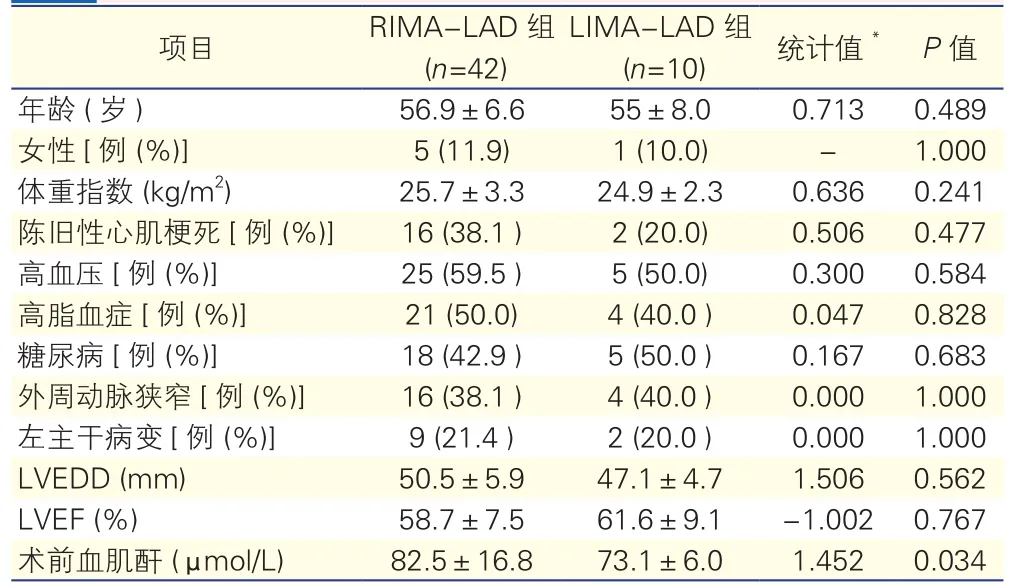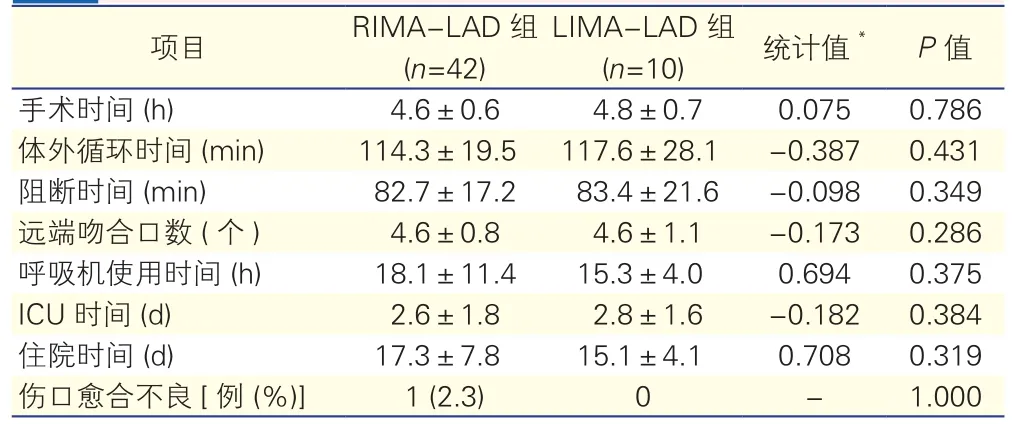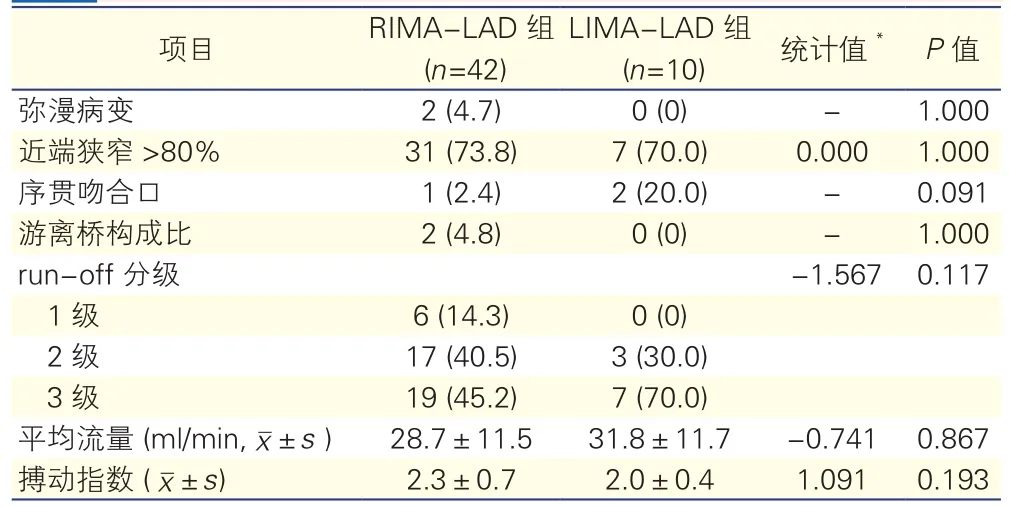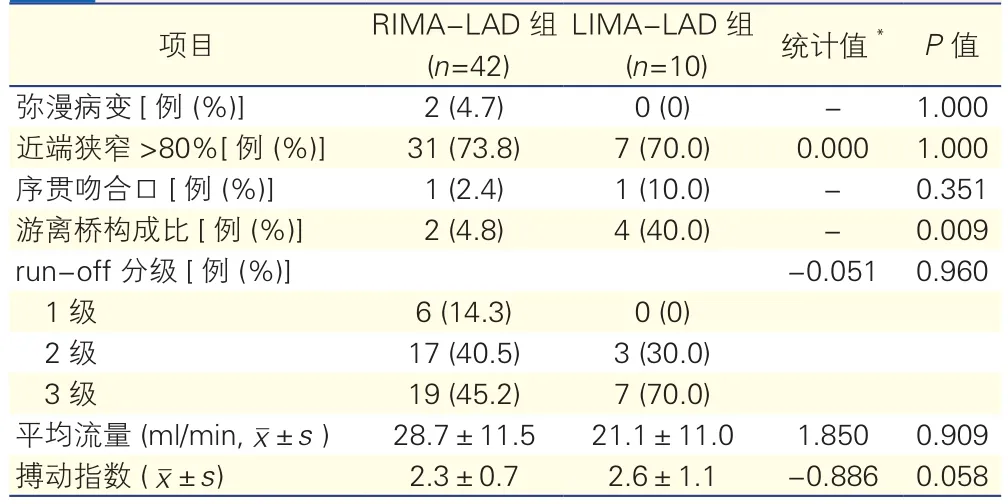使用双侧乳内动脉行冠状动脉旁路移植术动脉桥即时流量的初步研究
畅怡,王小啟, 郑哲, 樊红光, 李浩杰, 侯剑峰, 高歌
冠心病研究
使用双侧乳内动脉行冠状动脉旁路移植术动脉桥即时流量的初步研究
畅怡,王小啟, 郑哲, 樊红光, 李浩杰, 侯剑峰, 高歌
目的:使用双侧乳内动脉行冠状动脉旁路移植术(CABG)后的右乳内动脉(RIMA)桥血管流量分析,初步探讨动脉桥流量特性。
方法: 2015-12至2016-07选择在我院年龄<65岁、使用双侧乳内动脉行CABG患者52例,男46例,平均年龄(56.6±6.8)岁,根据前降支(LAD)移植血管材料分为两组,RIMA-LAD吻合组(n=42),左乳内动脉(LIMA)-LAD吻合组(n=10)。使用Veri Q系统行桥血管即时流量测定,比较手术结果及桥流量。
结果:52例患者无手术死亡, 1例患者出现伤口愈合不良,行清创缝合,余51例无手术并发症。RIMA-LAD组和LIMA-LAD组患者LAD桥平均流量分别为(28.7±11.5)ml/min和(31.8±11.7)ml/min,平均搏动指数为2.3±0.7和2.0±0.4,差异均无统计学意义(P>0.05);两组患者RIMA至不同靶血管平均流量[(28.7±11.5)ml /min vs(21.1±11.0)ml /min]、平均搏动指数(2.3±0.7 vs 2.6±1.1),差异均无统计学意义(P>0.05)。
结论:RIMA-LAD桥流量与LIMA-LAD桥流量相当,RIMA与其他靶血管吻合,桥流量满意,是稳定理想的冠状动脉旁路血管移植物。
冠状动脉旁路移植术;乳内动脉;局部血流
冠状动脉旁路移植术(CABG)是治疗冠心病的重要方法之一,尤其对于累及左主干及分叉的多支病变,疗效肯定。目前应用较多的血管移植物为左乳内动脉(LIMA)及大隐静脉,前者10年通畅率可达90%[1],而后者因取材方便且充足,仍在临床大量应用,但其10年通畅率仅为50%~60%[2]。鉴于此,全动脉化CABG一直是外科医生的追求,其远期通畅率和生存率的优势已被众多文献所证明[3-5],而右乳内动脉(RIMA)成为仅次于LIMA的第二选择[6,7]。关于右乳内动脉桥流量的研究很少,国内少有相关报道,本文旨在通过对双侧乳内动脉行CABG后RIMA桥流量的分析,初步探讨此种术式动脉桥流量特性以指导临床。
1 资料与方法
1.1 临床资料
2015-12 至2016-07期间,选择我院年龄<65岁、且需择期行单纯CABG的冠心病患者52例,男46例(88.5%),女6例,平均年龄(56.6±6.8)岁,均使用双侧乳内动脉(1例患者只使用双侧乳内动脉桥,51例患者均在此基础上使用大隐静脉桥)行CABG。排除标准:严重肥胖(体重指数>30 kg/m2)、心功能明显减低(左心室射血分数<35%)、合并锁骨下动脉开口狭窄、合并慢性阻塞性肺病及控制不佳的糖尿病。根据前降支(LAD)旁路血管材料分为两组: RIMA-LAD 组(n=42)和LIMA-LAD 组(n=10)。
1.2 手术方法
使用乳内动脉牵开器显露,使用电刀带蒂获取,先左侧后右侧。上端达锁骨下动脉起始部,下端达剑突水平,充分游离乳内动脉近端,保证其有效长度,全身肝素化后离断血管远端,予罂粟碱水纱布保护。所有患者均在体外循环下手术,先吻合远端,开放升主动脉后行游离血管的近端吻合。如果乳内动脉长度不足,将近端离断,作为游离血管吻合。动脉桥路径:RIMA-LAD组患者采用RIMA与LAD吻合、LIMA与对角支或钝缘支吻合; LIMA-LAD组患者采用LIMA与LAD吻合、RIMA与对角支、钝缘支、右冠状动脉或后降支吻合。
1.3 评价方法
弥漫病变及近端狭窄程度根据造影结果,以80%作为狭窄程度分界点;run-off根据术中探查结果,按照远端直径≤1.5 mm、1.75 mm及≥2 mm将run-off分为1级、2级和3级。患者吻合完成、停止体外循环后,取平均动脉压70 mmHg(1 mmHg=0.133 kPa) 状态下,使用Veri Q系统(Medistim,Norway)根据时差法流量测定原理测定桥血管流量,结果取平均流量(ml/min)及搏动指数(PI)分析。本研究仅比较乳内动脉桥流量。
1.4 统计学方法
连续数值变量使用均数±标准差( ±s)表示,分类变量采用例数及百分比表示。组间连续数值变量的比较采用两个独立样本t检验。组间分类变量的构成比比较采用四格表χ2检验,当所有格子频数均>5时取Pearson卡方结果,当有1个格子频数<5时,取连续性修正结果,当有2个格子频数<5时,取Fisher精确概率检验结果。组间等级分类变量的构成比比较采用Mann-Whitney检验。P值<0.05为差异有统计学意义。
2 结果
2.1 两组患者术前基线资料比较(表1)
术前除血肌酐外其余各项指标比较差异均无统计学意义。

表1 两组患者术前基线资料比较(±s)
2.2 两组患者的临床结果
52例患者均使用双侧乳内动脉(其中1例患者只使用双侧乳内动脉桥,51例患者均在此基础上使用大隐静脉桥)行CABG。RIMA-LAD组中有1例患者的RIMA为LAD与对角支的序贯吻合,2例患者RIMA与LAD为游离桥吻合,其中1例近端与静脉桥吻合,1例近端与升主动脉吻合;LIMA-LAD组2例患者的LIMA为LAD与对角支的序贯吻合;RIMA 常规走行在心脏表面,其中2例患者RIMA经心包横窦后方走行与靶血管吻合。52例患者平均远端吻合口数(4.6±0.8)个。平均手术时间(4.7±0.6)h,平均体外循环时间(114.8±20.6)min,平均阻断时间(82.8±17.6)min,平均呼吸机使用时间(17.6±10.5)h,平均重症监护病房(ICU)停留时间为(2.7±1.8)d。RIMA-LAD组1例患者术后伤口愈合不良,胸骨松动,经再次清创缝合后治愈,51例患者无其他并发症。
两组患者的平均手术时间、体外循环时间、阻断时间、远端吻合口数、呼吸机使用时间、 ICU 时间及住院时间比较,差异均无统计学意义( P>0.05,表 2)。

表2 两组患者手术资料比较( ±s)
2.3 两组患者LAD桥流量的比较 (表3)
两组患者靶血管在弥漫病变、近端狭窄>80%、run-off分级的构成比,差异均无统计学意义;序贯吻合口及游离桥构成比的差异均无统计学意义(P>0.05)。两组患者LAD的平均流量(图1)、平均搏动指数差异也均无统计学意义(P>0.05)。

表3 两组患者LAD桥流量比较[例(%)]

图1 双侧乳内动脉与不同靶血管吻合的流量
2.4 两组患者RIMA到不同靶血管流量的比较
两组患者靶血管在弥漫病变、近端狭窄>80%、run-off分级的构成比,差异均无统计学意义;序贯吻合口构成比的差异无统计学意义;RIMA-LAD 较LIMA-LAD组采用了较少的游离桥,差异有统计学意义(P<0.05)。两组RIMA至不同靶血管的平均流量、平均搏动指数,差异均无统计学意义(P>0.05,表4)。当RIMA与钝缘支及后降支吻合时,4例患者出现RIMA长度不足,改为游离桥,流量分别为45 ml/min、28 ml/min、28 ml/min及 18 ml/min。2例患者经心包横窦与对角支或高位钝缘支吻合,桥流量分别为25 ml/min和12 ml/min,搏动指数均<3。

表4 两组患者RIMA至不同靶血管流量比较
3 讨论
全动脉化CABG以其优异的患者生存率[3-5]越来越受到国内外学者的重视,其机制不仅仅是较高的动脉桥通畅率,还与动脉桥对于自身冠状动脉循环的保护效应相关[8]。使用双侧乳内动脉的CABG远期生存率明显优于单侧乳内动脉CABG[6,7]。虽然已经有明确证据支持,但临床上应用双侧乳内动脉的比例还很低,在5%~12%之间,这和外科医生对RIMA-LAD桥质量的顾虑有关。
对于乳内动脉的获取,目前仍是骨骼化获取与带蒂获取并存,目前尚无证据显示两种获取方法在乳内动脉流量上有差别,但骨骼化游离可以减轻术后疼痛及增加胸骨灌注,减少胸骨不愈合及深部感染的概率[9-11]。使用电刀进行骨骼化游离可能会导致乳内动脉痉挛,有学者建议使用超声刀游离能显著避免这一问题[12]。我们的经验是,游离时减小电刀输出功率、远离主干游离基本可以避免痉挛的问题。
对于LAD的桥血管选择,无论是LIMA还是RIMA,目前并无文献证明其差异。有学者[13]建议基于LAD的重要性及既往研究LIMA-LAD桥的优异结果,尽量使用LIMA与LAD吻合。我们认为,桥血管的选择需整体考虑,LIMA更靠近左冠系统,当回旋支需要再血管化时,LIMA能够提供更充足的长度,吻合成功率高,更便于行序贯吻合。所以,RIMA与LAD吻合,LIMA与其他左冠分支吻合是更理想的选择。本研究RIMA- LAD组患者RIMA至不同靶血管平均流量[(28.7±11.5)ml/min vs (21.1±11.0)ml/min],与LIMA-LAD桥搏动指数相当 (2.3±0.7 vs 2.6±1.1) ,证明RIMA-LAD桥的可靠性。影响桥血管流量的因素较多,如是否为弥漫病变、近端狭窄程度、远端吻合口数目、靶血管远端管径、外科吻合技术等,本研究试从以上方面对两组病例进行了比较,除了游离桥比例有显著差别外,其他主要影响因素在两组间均具有可比性,所有手术均为同一术者完成,外科技术应无差别。当LIMA与LAD吻合时,RIMA如何选择靶血管,目前尚有争议。一些学者的造影随访结果证实了RIMA与左冠分支吻合的优异结果[14-16],有文献提出RIMA与狭窄程度<70%的病变右冠状动脉主干吻合影响远期通畅率[17],而另一些学者从远期生存率角度研究,并未发现RIMA桥的吻合位置与其相关[13,18]。我们认为,RIMA的靶血管选择应综合考虑冠状动脉分布优势、靶血管病变程度等因素,当右冠优势且靶血管病变重(大于80%)、远端管腔好时,可以选择右冠状动脉作为靶血管;而当近端狭窄不重时,不选择RIMA作为桥血管。本研究LIMA-LAD组患者RIMA与LAD外的其他靶血管吻合,RIMA至不同靶血管平均桥流量( 21.1±11.0)ml/min,平均搏动指数与RIMA-LAD组比较差异均无统计学意义,流量可靠。
本研究中,当RIMA与钝缘支及后降支吻合时,4例患者出现RIMA长度不足,改为游离桥,流量分 别 为 45 ml/min、28 ml/min、28 ml/min及 18 ml/min,以即时流量评价,游离RIMA桥也能保证满意效果;有学者认为与原位RIMA桥相比游离RIMA桥会降低通畅率[19],但从远期生存率来看,RIMA是否为游离影响不大[7]。而原位RIMA与对角支及高位钝缘支吻合时,其路径分为两种,主动脉前方和经心包横窦,Puig等[20]提倡经心包横窦走行,避免右侧乳内动脉在胸骨正后方,Ura等[21]经长期造影随访发现这种方式吻合的RIMA桥6年通畅率为89.3%,同时LIMA-LAD桥的通畅率为94.5%,差异无统计学意义,证明其可靠的效果。本研究中2例患者经此路径走行,桥流量分别为25 ml/min和12 ml/min,搏动指数均<3,尚需要更多例数说明其效果。
本研究的局限性为总体例数仍较少,两组样本量差别较大,未能对影响流量的因素进行多因素回归分析,结论的外延性有限,需在后续研究中增加样本量继续分析。
总之,使用BIMA行CABG,早期结果良好,并发症率较低,RIMA-LAD桥与LIMA-LAD桥的流量相当,RIMA与其他靶血管吻合时,即时血流量评价桥质量可靠,所以,RIMA是稳定理想的冠状动脉旁路血管移植物。
[1] Barner HB, Swartz MT, Mudd JG, et al. Late patency of the internal mammary artery as a coronary bypass conduit. Ann Thorac Surg, 1982,34: 408-412.
[2] Bourassa MG. Fate of venous grafts: The past, the present and the future. J Am Coll Cardiol, 1991, 17: 1081-1083.
[3] Buxton BF, Shi WY, Tatoulis J, et al. Total arterial revascularization with internal thoracic and radial artery grafts in triple-vessel coronary artery disease is associated with improved survival. J Thorac Cardiovasc Surg, 2014, 148: 1238-1243.
[4] Locker C, Schaff HV, Dearani JA, et al. Multiple arterial grafts improve late survival of patients undergoing coronaryartery bypass graft surgery:analysis of 8622 patients with multivessel disease. Circulation, 2012,126: 1023-1230.
[5] Zacharias A, Schwann TA, Riordan CJ, et al. Late results of conventional versus all-arterial revascularization based on internalthoracic and radial artery grafting. Ann Thorac Surg, 2009, 87:19-26.
[6] Kelly R, Buth KJ, Légaré JF. Bilateral internal thoracic artery grafting is superior to other forms of multiple arterial grafting in providing survival benefit after coronary bypass surgery. J Thorac Cardiovasc Surg, 2012, 144: 1408-1415.
[7] Shi WY, Hayward PA, Tatoulis J, et al. Are all forms of total arterial revascularization equal? A comparison of single versus bilateral internal thoracic artery grafting strategies. J Thorac Cardiovasc Surg,2015 , 150: 1526-1533.
[8] Dimitrova KR, Hoffman DM, Geller CM, et al. Arterial grafts protect the native coronary vessels from atherosclerotic disease progression.Ann Thorac Surg, 2012, 94: 4754-4781.
[9] Boodhwani M, Nathan HJ, Lam BK. et al. The internal thoracic artery skeletonization study: A paired, within-patient comparison. Trials,2006, 7: 1.
[10] Boodhwani M, Lam BK, Nathan HJ, et al. Skeletonized internal thoracic artery harvest reduces pain and dysesthesia and improves sternal perfusion after coronary artery bypass surgery: a randomized,double-blind, within-patient comparison. Circulation, 2006, 114:766-773.
[11] Deja MA, Wos S, Golba KS, et al. Intraoperative and laboratory evaluation of skeletonized versus pedicled internal thoracic artery. Ann Thorac Surg, 1999, 68: 2164-2168.
[12] 李儒正, 天野篤, 廣瀬仁, 等. 超声刀在骨骼化动脉血管桥采取中的应用. 中国心血管病研究杂志, 2006, 4: 429-431.
[13] Kurlansky PA, Traad EA, Dorman MJ, et al. Location of the second internal mammary artery graft does not influence outcome of coronary artery bypass grafting. Ann Thorac Surg, 2011 , 91: 1378-1383.
[14] Buche M, Schroeder E, Chenu P, et al. Revascularization ofthe circumflex artery with the pedicled right internal thoracic artery:clinical functional and angiographic midtermresults. J Thorac Cardiovasc Surg, 1995, 110: 1338-1343.
[15] Ura M, Sakata R, Nakayama Y, et al. Analysis by early angiography of right internal thoracic artery grafting via the transverse sinus.Circulation, 2000, 101: 640-646.
[16] Bonacchi M, Prifti E, Battaglia F, et al. Insitu retrocaval skeletonized right internal thoracic artery anastomosed to the circumflex system via transverse sinus: technical aspects and postoperative outcome. J Thorac Cardiovasc Surg, 2003, 126: 1302-1313.
[17] Buxton BF, Ruengsakulrach P, Fuller J, et al. The right internal thoracic artery graft—benefits of grafting the left coronary system and native vessels with a high grade stenosis. Eur J Cardiothorac Surg,2000, 18: 255-261.
[18] Sabik JF, Stockins A, Nowicki ER, et al. Does location of the second internal thoracic artery graft influence outcome of coronary artery bypass grafting? Circulation , 2008, 118(Suppl): S210-215.
[19] Taggart DP, D’Amico R, Altman DG. Effect of arterial revascularisation on survival: a systematic review of studies comparing bilateral and single internal mammary arteries. Lancet, 2001, 358:870-875.
[20] Puig LB, Neto LF, Rati M, et al. A technique of anastomosis of the right internal mammary artery to the circumflex artery and its branches. Ann Thorac Surg, 1984, 38: 533-534.
[21] Ura M, Sakata R, Nakayama Y, et al. Long-term patency rate of right internal thoracic artery bypass via the transverse sinus. Circulation.1998,98: 2043-2048.
2016-11-25)
(编辑:曹洪红)
Preliminary Research of Immediate Graft Flow in Coronary Artery Bypass Grafting Using Bilateral Internal Mammary Artery
CHANG Yi, WANG Xiao-qi, ZHENG Zhe, FAN Hong-guang, LI Hao-jie, HOU Jian-feng, GAO Ge.
Department of Cardiac Surgery, National Center for Cardiovascular Disease and Fuwai Hospital, CAMS and PUMC, Beijing(100037), China
WANG Xiao-qi, Email: wxqfwn@163.com
Objective: To preliminarily analyze the graft fl ow of right internal mammary artery (RIMA) in patients after coronary artery bypass grafting (CABG) using bilateral internal mammary artery (BIMA).
CABG by BIMA in our hospital from 2015-12 to 2016-07 were studied. The patients were younger than 65 years at the mean age of (56.6±6.8) years including 46 male. According to conduit grafting to left anterior descending artery (LAD), the patients were divided into 2 groups: RIMA anastomosed to LAD group, n=42 and LIMA anastomosed to LAD group, n=10. The immediate graft fl ow was measured by Veri Q system, surgical outcomes and graft fl ows were compared between 2 groups.
Results: There were no operative death in all 52 patients, 1 had poor wound healing and received debridement and suturing, no one had operative complication in left 51 patients. The average LAD bridge fl ow in both groups were (28.7±11.5)ml/min and (31.8± 11.7) ml/min, the mean pulsation index (PI) were (2.3±0.7) and (2.0±0.4), P>0.05; the average RIMA graft fl ow were (28.7±11.5) ml/min and (21.1±11.0) ml/min, the mean PI were (2.3±0.7) and (2.6±1.1), P>0.05.
Conclusion: Flows in RIMA-LAD graft and LIMA-LAD graft were similar; the fl ow of RIMA anastomosed to other target vessel was satisfactory which was an ideal graft for CABG.
Coronary artery bypass grafting; Internal mammary artery; Regional blood fl ow
100037 北京市,中国医学科学院 北京协和医学院 国家心血管病中心 阜外医院 成人外科中心
畅怡 主治医师 博士 主要从事心血管病的外科治疗及相关流体力学研究 Email: chantlinguish@163.com 通讯作者:王小啟Email: wxqfwn@163.com
R541
A
1000-3614(2017)11-1080-05
10.3969/j.issn.1000-3614.2017. 11.009
(Chinese Circulation Journal, 2017,32:1080.)

